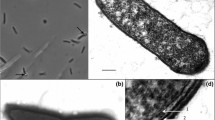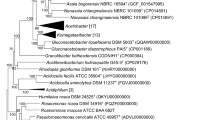Abstract
Clostridium mayombei sp. nov., a previously undescribed H2-oxidizing CO2-reducing acetogenic bacterium, was isolated from gut contents of the African soilfeeding termite, Cubitermes speciosus. Cells were anaerobic, Gram positive, catalase and oxidase negative, endospore-forming motile rods which measured 1×2 – 6 μm and which had a DNA base composition of 25.6 mol% G+C (strain SFC-5). Optimum conditions for growth on H2+CO2 were at 33°C and pH 7.3, and under these conditions cells produced acetate according to the equation: 4 H2+2 CO2→CH3COOH+2 H2O. Other substrates supporting good growth included carbohydrates (e.g. glucose, xylose, starch), sugar alcohols, and organic and amino acids, and with these substrates acetate was almost always the principle fermentation product. Comparative analysis of 16S rRNA nucleotide sequences confirmed that C. mayombei was closely related to various members of the genus Clostridium. However, morphological and physiological differences between C. mayombei and other homoacetogenic clostridia were deemed significant enough to warrant creation of a new taxon. Results are discussed in light of the diversity of H2/CO2 acetogens recently isolated from various termites, and in terms of the relative importance of H2/CO2 acetogenesis to termite nutrition.
Similar content being viewed by others
References
Adamse AD (1980) New isolation of Clostridium aceticum (Wieringa). Antonie van Leeuwenhoek 46: 523–531
Adamse AD, Velzeboer CTM (1982) Features of a Clostridium, strain CV-AA1, an obligatory anaerobic bacterium producing acetic acid from methanol. Antonie van Leeuwenhoek 48: 305–313
Andreesen JR, Gottschalk G, Schlegel HG (1970) Clostridium formicoaceticum nov. spec. isolation, description and distinction from C. aceticum and C. thermoaceticum. Arch Microbiol 72: 154–170
Braun M, Mayer F, Gottschalk G (1981) Clostridium aceticum (Wieringa), a microorganism producing acetic acid from molecular hydrogen and carbon dioxide. Arch Microbiol 128: 288–293
Breznak JA, Kane MD (1990) Microbial H2/CO2 acetogenesis in animal guts: nature and nutritional significance. FEMS Microbiol Rev 87: 309–314
Breznak JA, Switzer JM (1986) Acetate synthesis from H2 plus CO2 by termite gut microbes. Appl Environ Microbiol 52: 623–630
Breznak JA, Blum JS, (1991) Mixotrophy in the termite gut acetogen, Sporomusa termitida. Arch Microbiol 156: 105–110
Breznak JA, Switzer JM, Seitz H-J (1988) Sporomusa termitida sp. nov., an H2/CO2-utilizing acetogen isolated from termites. Arch Microbiol 150: 282–288
Cato EP, George WL, Finegold SM (1986) Genus Clostridium Prazmowski 1880, 23AL. In: Sneath PHA, Mair NS, Sharpe ME, Holt JG (eds) Bergey's manual of systematic bacteriology,vol. 2. Williams & Wilkins, Baltimore, pp 1141–1200
Cord-Ruwisch R, Seitz H-J, Conrad R (1988) The capacity of hydrogenotrophic anaerobic bacteria to compete for traces of hydrogen depends on the redox potential of the electron acceptor. Arch Microbiol 149: 350–357
Dehning I, Stieb M, Schink B (1989) Sporomusa malonica sp. nov., a homoacetogenic bacterium growing by decarboxylation of malonate or succinate. Arch Microbiol 151: 421–426
Fontaine FE, Peterson WH, McCoy E, Johnson MJ, Ritter GJ (1941) A new type of glucose fermentation by Clostridium thermoaceticum n. sp. J Bacteriol 43: 701–715
Honigberg BM (1970) Protozoa associated with termites and their role in digestion. In: Krishna K, Weesner FM (eds) Biology of termites, vol 2. Academic Press, New York, pp 1–36
Kane MD, Breznak JA (1991) Acetonema longum gen. nov. sp. nov., an H2/CO2 acetogenic bacterium from the termite, Pterotermes occidentis. Arch Microbiol 156: 91–98
Lee KE, Wood TG (1971) Termites and soils. Academic Press, New York, 251 pp
Mackey BM, Parsons SE, Miles CA, Owen RJ (1988) The relationship between the base composition of bacterial DNA and its intracellular melting temperature as determined by differential scanning calorimetry. J Gen Microbiol 134: 1185–1195
Schink B (1984) Clostridium magnum sp. nov., a non-autotrophic homoacetogenic bacterium. Arch Microbiol 137: 250–255
Schink B, Pfennig N (1982) Propionigenium modestum gen. nov. sp. nov., a new strictly anaerobic, nonsporing bacterium growing on succinate. Arch Microbiol 133: 209–216
Wiegel J, Braun M, Gottschalk G (1981) Clostridium thermoautotrophicum species novum, a thermophile producing acetate from molecular hydrogen and carbon dioxide. Curr Microbiol 5: 255–260
Author information
Authors and Affiliations
Rights and permissions
About this article
Cite this article
Kane, M.D., Brauman, A. & Breznak, J.A. Clostridium mayombei sp. nov., an H2/CO2 acetogenic bacterium from the gut of the African soil-feeding termite, Cubitermes speciosus . Arch. Microbiol. 156, 99–104 (1991). https://doi.org/10.1007/BF00290980
Received:
Accepted:
Published:
Issue Date:
DOI: https://doi.org/10.1007/BF00290980




